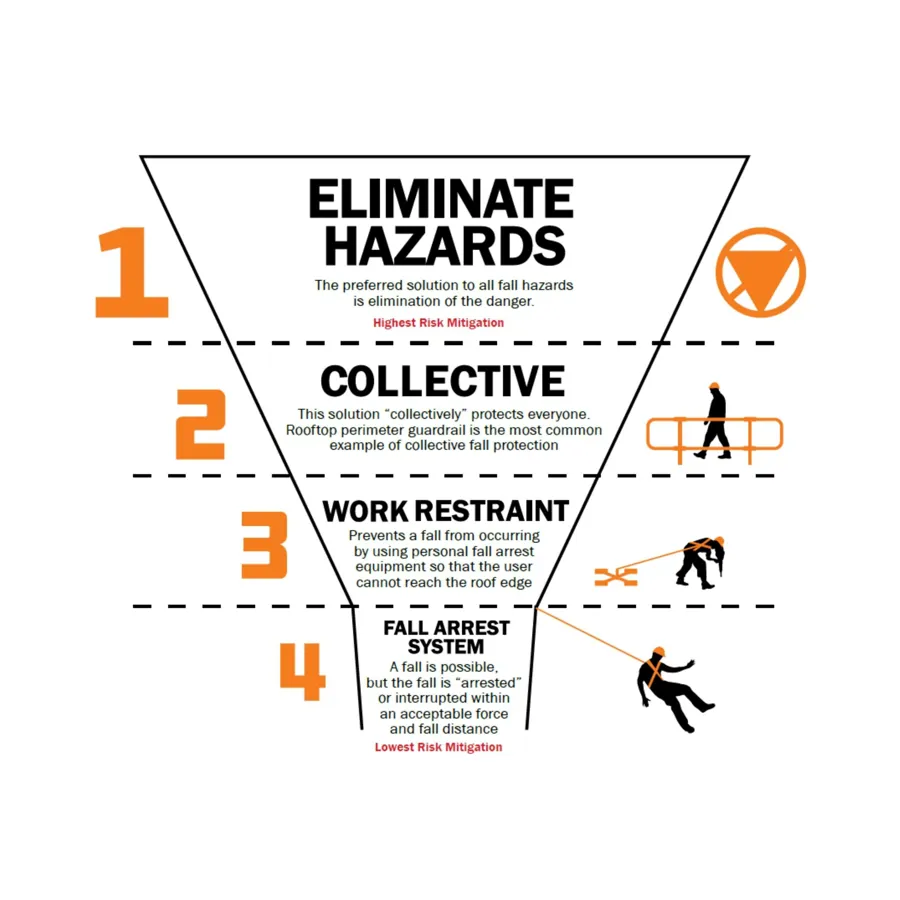
You are visiting the Canada Kee Safety website from United States. Would you like to go to the United States site?

“Up on the Roof,” written by Carole King and Gerry Goffin, romanticizes getting away from it all in a paradise that is “trouble-proof.” Yes, building owners, facility managers, and their maintenance and repair workers who must access the roof would agree that a trouble-proof roof is paradise. In the real world, though, there are several hazards on a typical commercial, institutional, or industrial rooftop, not the least of which is the roof edge.
A compliant guardrail system is the best roof edge protection solution for a flat or low-slope roof. It collectively protects multiple workers without needing special fall protection equipment or training. To meet Canadian Occupational Health and Safety regulations, the guardrail must be highly visible, have a top rail between 34 and 42 inches high from its base, with a horizontal mid rail, supporting posts no more than 10 feet apart at their centres, and be able to withstand a static load of 890 N applied in any direction at any point on the top rail.
What else should you consider when choosing a rooftop guardrail?
Although “Up on the Roof” is a pop tune, for roof fall protection, a metal safety railing system will best provide the strength and durability needed to meet national, provincial, and territorial standards. Lightweight aluminum or galvanized steel are popular choices. Both types are corrosion-resistant and can be powder-coated for added visibility. Aluminum is looked upon as more aesthetic.
A modular, component-based guardrail system that does not penetrate the roof membrane will conform to the roof layout and is easy to install. There is virtually no maintenance needed, and if the rooftop’s requirements change (e.g., an HVAC system is replaced or relocated), the guardrail system can be reconfigured.

For flat or low-sloped roofs accessed frequently and requiring a permanent solution, choose a roof edge guardrail system with an angled, cantilever design and counterbalanced weights.
In confined or narrow spaces, the same modular, component-based concept can be used; however, a roof guardrail system with upright posts and base weights that fit into the posts can accommodate such areas. This type of railing set is quick and easy to assemble and disassemble, so it is also ideal for temporary or infrequent work.
A standing seam and other metal roofs require a different way to secure the railings. A guardrail system with a galvanized base plate with multiple fixing centers will affix to metal roofs and provide compliant fall protection.

Perimeter guardrails are not the only areas of a rooftop where railings can protect workers. A roof walkway with guardrails provides an anti-slip walking surface along a delineated protected route.
Workers may also need to reach greater heights to service large equipment. Roof platforms, which incorporate modular railings and anti-slip steps and platforms, enable workers to perform their tasks with optimum fall protection.

Two common ways to enter and leave the roof are via a ladder system or a roof hatch, where guardrails should also be used for fall protection. For ladders, guardrails with extra support need to flank the ladder access point and be backed up with a self-closing safety gate.
A roof hatch guardrail system—which also integrates a self-closing gate— will protect workers from falling through the open sides of the hatch.

Certified working-at-height training covers a range of fall protection legislation and the installation, testing, and operation of fall protection equipment. Theoretical content includes types and methods of fall protection.
Working on a roof is inherently dangerous, and building owners and employers are responsible for reducing the risk factors. When adequately protected by guardrails and related fall protection systems, workers performing their construction, maintenance, and repair tasks will sing out with praise.

A truly comprehensive rooftop solution follows the Hierarchy of Fall Protection. An expert starts by inspecting the roof site for potential fall hazards. From there, a complete system solution and recommendations are created that descend down the four levels of the hierarchy, from simple, sensible approaches for eliminating risks all the way down to lifesaving personal protection systems.
Collective Systems require no additional training to use. Fall Restraint and Fall Arrest Systems both require a high level of user competency, training and additional inspection to be used properly.